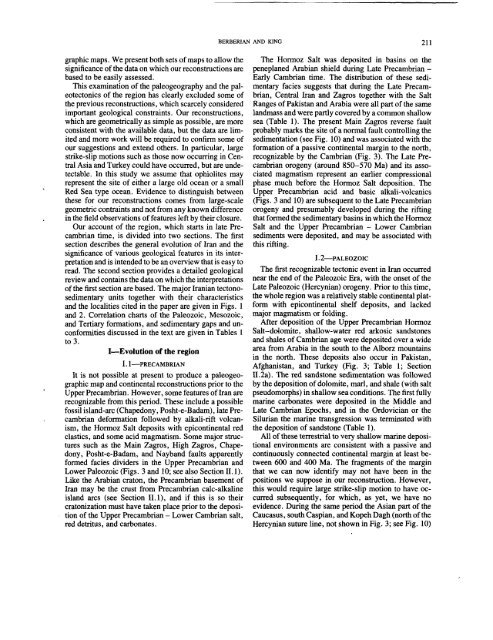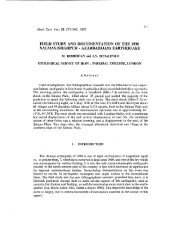PDF COPY - Manuel berberian
PDF COPY - Manuel berberian
PDF COPY - Manuel berberian
Create successful ePaper yourself
Turn your PDF publications into a flip-book with our unique Google optimized e-Paper software.
graphic maps. We present both sets of maps to allow the<br />
significance of the data on which our reconstructions are<br />
based to be easily assessed.<br />
This examination of the paleogeography and the paleotectonics<br />
of the region has clearly excluded some of<br />
the previous reconstructions, which scarcely considered<br />
important geological constraints. Our reconstructions,<br />
which are geometrically as simple as possible, are more<br />
consistent with the available data, but the data are limited<br />
and more work will be required to confirm some of<br />
our suggestions and extend others. In particular, large<br />
strike-slip motions such as those now occurring in Central<br />
Asia and Turkey could have occurred, but are undetectable.<br />
In this study we assume that ophiolites may<br />
represent the site of either a large old ocean or a small<br />
Red Sea type ocean. Evidence to distinguish between<br />
these for our reconstructions comes from large-scale<br />
geometric contraints and not from any known difference<br />
in the field observations of features left by their closure.<br />
Our account of the region, which starts in late Precambrian<br />
time, is divided into two sections. The first<br />
section describes the general evolution of Iran and the<br />
significance of various geological features in its interpretation<br />
and is intended to be an overview that is easy to<br />
read. The second section provides a detailed geological<br />
review and contains the data on which the interpretations<br />
of the first section are based. The major Iranian tectonosedimentary<br />
units together with their characteristics<br />
and the localities cited in the paper are given in Figs. 1<br />
and 2. Correlation charts of the Paleozoic, Mesozoic,<br />
and Tertiary formations, and sedimentary gaps and unconformities<br />
discussed in the text are given in Tables 1<br />
to3.<br />
1--Evolution of the region<br />
I. 1--PRECAMBRIAN<br />
It is not possible at present to produce a paleogeographic<br />
map and continental reconstructions prior to the<br />
Upper Precambrian. However, some features of Iran are<br />
recognizable from this period. These include a possible<br />
fossil island-arc (Chapedony, Posht-e-Badam), late Precambrian<br />
deformation followed by alkali-rift volcanism,<br />
the Hormoz Salt deposits with epicontinental red<br />
elastics, and some acid magmatism. Some major structures<br />
such as the Main Zagros, High Zagros, Chapedony,<br />
Posht-e-Badam, and Nayband faults apparently<br />
formed facies dividers in the Upper Precambrian and<br />
Lower Paleozoic (Figs. 3 and 10; see also Section II. 1).<br />
Like the Arabian craton, the Precambrian basement of<br />
Iran may be the crust from Precambrian calc-alkaline<br />
island arcs (see Section II.1), and if this is so their<br />
cratonization must have taken place prior to the deposition<br />
of the Upper Precambrian - Lower Cambrian salt,<br />
red detritus, and carbonates.<br />
BERBERIAN AND KING 211<br />
The Hormoz Salt was deposited in basins on the<br />
peneplaned Arabian shield during Late Precambrian-<br />
Early Cambrian time. The distribution of these sedimentary<br />
facies suggests that during the Late Precambrian,<br />
Central Iran and Zagros together with the Salt<br />
Ranges of Pakistan and Arabia were all part of the same<br />
landmass and were partly covered by a common shallow<br />
sea (Table 1). The present Main Zagros reverse fault<br />
probably marks the site of a normal fault controlling the<br />
sedimentation (see Fig. 10) and was associated with the<br />
formation of a passive continental margin to the north,<br />
recognizable by the Cambrian (Fig. 3). The Late Precambrian<br />
orogeny (around 850-570 Ma) and its associated<br />
magmatism represent an earlier compressional<br />
phase much before the Hormoz Salt deposition. The<br />
Upper Precambrian acid and basic alkali-volcanics<br />
(Figs. 3 and 10) are subsequent to the Late Precambrian<br />
orogeny and presumably developed during the rifting<br />
that formed the sedimentary basins in which the Hormoz<br />
Salt and the Upper Precambrian - Lower Cambrian<br />
sediments were deposited, and may be associated with<br />
this rifting.<br />
1.2--PALEOZOIC<br />
The first recognizable tectonic event in Iran occurred<br />
near the end of the Paleozoic Era, with the onset of the<br />
Late Paleozoic (Hercynian) orogeny. Prior to this time,<br />
the whole region was a relatively stable continental platform<br />
with epicontinental shelf deposits, and lacked<br />
major magmatism or folding.<br />
After deposition of the Upper Precambrian Hormoz<br />
Salt-dolomite, shallow-water red arkosic sandstones<br />
and shales of Cambrian age were deposited over a wide<br />
area from Arabia in the south to the Alborz mountains<br />
in the north. These deposits also occur in Pakistan,<br />
Afghanistan, and Turkey (Fig. 3; Table 1; Section<br />
II.2a). The red sandstone sedimentation was followed<br />
by the deposition of dolomite, marl, and shale (with salt<br />
pseudomorphs) in shallow sea conditions. The first fully<br />
marine carbonates were deposited in the Middle and<br />
Late Cambrian Epochs, and in the Ordovician or the<br />
Silurian the marine transgression was terminated with<br />
the deposition of sandstone (Table 1).<br />
All of these terrestrial to very shallow marine depositional<br />
environments are consistent with a passive and<br />
continuously connected continental margin at least between<br />
600 and 400 Ma. The fragments of the margin<br />
that we can now identify may not have been in the<br />
positions we suppose in our reconstruction. However,<br />
this would require large strike-slip motion to have occurred<br />
subsequently, for which, as yet, we have no<br />
evidence. During the same period the Asian part of the<br />
Caucasus, south Caspian, and Kopeh Dagh (north of the<br />
Hercynian suture line, not shown in Fig. 3; see Fig. 10)







